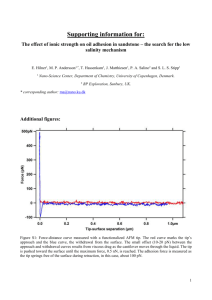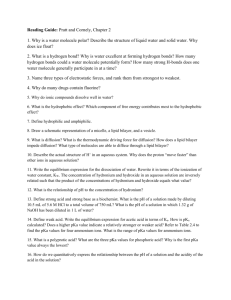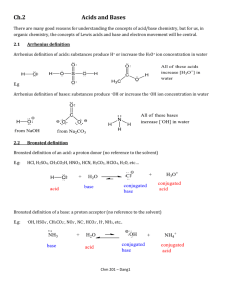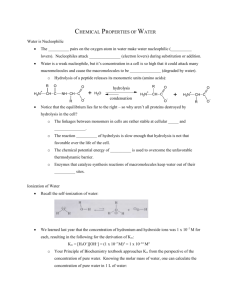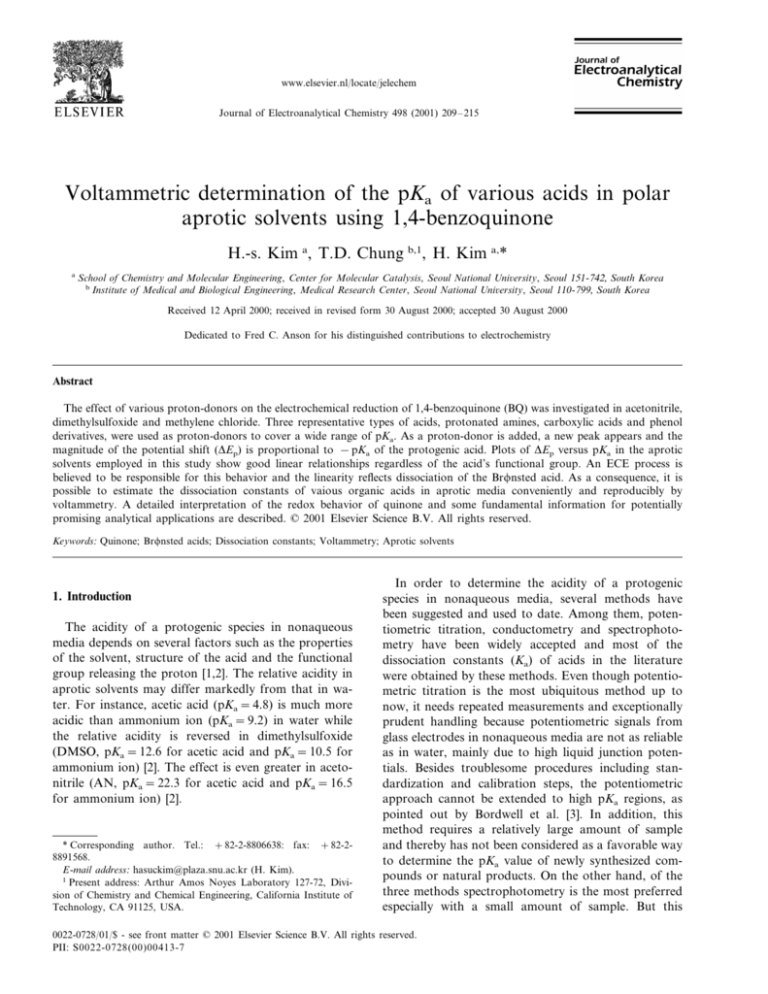
www.elsevier.nl/locate/jelechem
Journal of Electroanalytical Chemistry 498 (2001) 209– 215
Voltammetric determination of the pKa of various acids in polar
aprotic solvents using 1,4-benzoquinone
H.-s. Kim a, T.D. Chung b,1, H. Kim a,*
a
School of Chemistry and Molecular Engineering, Center for Molecular Catalysis, Seoul National Uni6ersity, Seoul 151 -742, South Korea
b
Institute of Medical and Biological Engineering, Medical Research Center, Seoul National Uni6ersity, Seoul 110 -799, South Korea
Received 12 April 2000; received in revised form 30 August 2000; accepted 30 August 2000
Dedicated to Fred C. Anson for his distinguished contributions to electrochemistry
Abstract
The effect of various proton-donors on the electrochemical reduction of 1,4-benzoquinone (BQ) was investigated in acetonitrile,
dimethylsulfoxide and methylene chloride. Three representative types of acids, protonated amines, carboxylic acids and phenol
derivatives, were used as proton-donors to cover a wide range of pKa. As a proton-donor is added, a new peak appears and the
magnitude of the potential shift (DEp) is proportional to −pKa of the protogenic acid. Plots of DEp versus pKa in the aprotic
solvents employed in this study show good linear relationships regardless of the acid’s functional group. An ECE process is
believed to be responsible for this behavior and the linearity reflects dissociation of the Brfnsted acid. As a consequence, it is
possible to estimate the dissociation constants of vaious organic acids in aprotic media conveniently and reproducibly by
voltammetry. A detailed interpretation of the redox behavior of quinone and some fundamental information for potentially
promising analytical applications are described. © 2001 Elsevier Science B.V. All rights reserved.
Keywords: Quinone; Brfnsted acids; Dissociation constants; Voltammetry; Aprotic solvents
1. Introduction
The acidity of a protogenic species in nonaqueous
media depends on several factors such as the properties
of the solvent, structure of the acid and the functional
group releasing the proton [1,2]. The relative acidity in
aprotic solvents may differ markedly from that in water. For instance, acetic acid (pKa =4.8) is much more
acidic than ammonium ion (pKa =9.2) in water while
the relative acidity is reversed in dimethylsulfoxide
(DMSO, pKa = 12.6 for acetic acid and pKa =10.5 for
ammonium ion) [2]. The effect is even greater in acetonitrile (AN, pKa =22.3 for acetic acid and pKa = 16.5
for ammonium ion) [2].
* Corresponding author. Tel.: +82-2-8806638: fax: +82-28891568.
E-mail address: hasuckim@plaza.snu.ac.kr (H. Kim).
1
Present address: Arthur Amos Noyes Laboratory 127-72, Division of Chemistry and Chemical Engineering, California Institute of
Technology, CA 91125, USA.
In order to determine the acidity of a protogenic
species in nonaqueous media, several methods have
been suggested and used to date. Among them, potentiometric titration, conductometry and spectrophotometry have been widely accepted and most of the
dissociation constants (Ka) of acids in the literature
were obtained by these methods. Even though potentiometric titration is the most ubiquitous method up to
now, it needs repeated measurements and exceptionally
prudent handling because potentiometric signals from
glass electrodes in nonaqueous media are not as reliable
as in water, mainly due to high liquid junction potentials. Besides troublesome procedures including standardization and calibration steps, the potentiometric
approach cannot be extended to high pKa regions, as
pointed out by Bordwell et al. [3]. In addition, this
method requires a relatively large amount of sample
and thereby has not been considered as a favorable way
to determine the pKa value of newly synthesized compounds or natural products. On the other hand, of the
three methods spectrophotometry is the most preferred
especially with a small amount of sample. But this
0022-0728/01/$ - see front matter © 2001 Elsevier Science B.V. All rights reserved.
PII: S0022-0728(00)00413-7
210
H.-s. Kim et al. / Journal of Electroanalytical Chemistry 498 (2001) 209–215
method needs chromogenic indicators, whose absorption spectra are sensitive to the proton concentration
and requires the prior knowledge of pKa values in a
given solvent [4,5]. Moreover, this method may suffer
from serious error if the acid exhibits considerable
chromogenic properties. Conductometry is considered
inferior to the two methods mentioned above in terms
of accuracy.
In addition to the conventional methods, voltammetry can be employed for the same purpose. Voltammetry has valuable advantages over other methods, such
as being relatively simple and convenient, requiring
only a small amount of sample for accurate measurement and covering a wide pKa range. With regard to
the voltammetric determination of pKa in nonaqueous
solvents, Sawyer and coworkers utilized the half-peak
potential of proton reduction to determine the effective
acidity of Brfnsted acids [6]. Also Vianello and
coworkers showed that the electrochemical reduction of
NH-protic a-bromo amide, which was used as an additive, can be utilized to determine the pKa of weak acids
in dimethylformamide (DMF) [7]. These two reports
demonstrated that voltammetry is a useful technique to
determine pKa values of weak acids and also suggested
that the acidity of an intermediate with a short life time
can be measured by voltammetry. However complicated calculations and/or simulations for the chemical
reactions involved in the electrochemical process have
limited its application. In order to overcome the limitation, it is necessary to use a stable additive, whose
electrochemical behavior is simple and well established.
In addition, the additive must have at least one voltammetric parameter that is sensitive to the acidity and can
be measured easily.
A polarographic method to determine the concentration of acids in aqueous medium through the electrochemical reduction of quinone was suggested for the
first time in 1963 [8]. Based on this fundamental idea,
Takamura and coworkers reported a linear relationship
between E1/2 of methyl-p-benzoquinone and pKa of
several carboxylic acids and phenol derivatives in 2methoxyethanol as well as in aqueous solution [9–11].
Similar work has been reported in DMF by DemangeGuerin [12] and by Kheifets et al. [13,14]. In these
studies, only a few acids were tested to demonstrate
that quinone can serve as an additive to quantify the
mixed acids selectively. Also pKa values of various
weak acids were estimated on the basis of the half-wave
potential (E1/2) of the new waves by dc polarography.
In terms of convenience in the measurement, E1/2 in dc
polarography, however, is not as good as the peak
potential (Ep) in linear sweep voltammetry. In addition,
it should be noted that solid electrodes are more practical to use in proton-deficient nonaqueous media compared to mercury as the working electrode material.
Recently, it was reported that quinone derivatives were
successfully employed to quantify the organic acids or
amines and to determine the enzymatic activities by
amperometry [9,15]. In spite of the well designed study,
no attempt was made to determine pKa in nonaqueous
media.
In the present report, systematic evaluation of the
voltammetric behavior of quinone is carried out in the
presence of various proton-donors such as protonated
amines, carboxylic acids and phenol derivatives in acetonitrile, dimethylsulfoxide and methylene chloride
(MC), which are different in polarity and basicity. In
addition, the feasibility of its practical application to
determine pKa and the solvent effect are described.
2. Experimental
Electrochemical experiments were performed with a
Windows-driven BAS100B/W electrochemical analyzer
(Bioanalytical Systems, West Lafayette, IN) using a
conventional three-electrode cell, with a glassy carbon
working electrode (area; 0.071 cm2), platinum wire
counter electrode and Ag Ag+ 0.1 M AgNO3 reference electrode, separated from the solution by a Vycor
plug. The surface of the working electrode was polished
with 0.3 mm alumina (Buehler, Lake Bluff, MN), then
rinsed with deionized water and washed carefully with
the solvent to be used. The supporting electrolyte was
0.1 M tetrabutylammonium perchlorate (TBAP). The
concentration of 1,4-benzoquinone (BQ) was 0.50 mM
and an appropriate amount of acid was added with a
micro-syringe. All experiments were carried out under a
nitrogen atmosphere and the solution temperature was
maintained at 25.09 0.1°C by a thermostat (model B,
Lauda-Königshofen, Germany).
HPLC grade AN, DMF and MC from Fisher and
DMSO for spectroscopy from Merck were used as
solvents. BQ was purchased from Junsei Chemical.
n-Butylammonium perchlorate and tri-n-butylammonium perchlorate were synthesized from the corresponding amines and perchloric acid. Other reagents
were obtained from Aldrich. Hygroscopic reagents were
dried for 48 h under reduced pressure at 20°C.
3. Results and discussion
3.1. New reduction peak caused by Brnsted acids
In the proton-deficient environment, two pairs of
reversible redox waves are generally observed by cyclic
voltammetry of BQ [16,17]. These two reduction peaks
are due to the electrochemical reduction producing a
monoanion radical (BQ−) and a dianion (BQ2 − ), respectively. The voltammetric behavior of BQ changes
significantly when a Brfnsted acid is added to the
H.-s. Kim et al. / Journal of Electroanalytical Chemistry 498 (2001) 209–215
solution. The redox behavior of BQ strongly depends
on the strength of the Brfnsted acid. Concerning the
effect of the Brfnsted acid, Gupta and Linschitz
showed that weak hydrogen-bonding agents or weak
Brfnsted acids such as alcohols (pKa \9.3 in aqueous
media) interact with neither BQ nor BQ− while BQ2 −
associates with the acids by hydrogen-bonding [18].
According to this report, the second reduction peak
producing BQ2 − shifted to the positive direction and
the potential value varied with the concentration of the
agents, whereas the first reduction peak producing
BQ− remained intact. The report also demonstrated
that the presence of acids with medium or strong
acidity commonly gave rise to a new peak prior to the
first reduction peak but the mechanism was different,
ECE (e−H+e−) and prior protonation, respectively.
The acidity of the Brfnsted acids as well as the basicity
of the quinones influenced the species responsible for
the new peak.
211
Table 1 lists the pKa values of organic acids that have
been tested in the present study. Except for some
protonated alkylamines, pKa values of all the acids are
less than 9 in aqueous media. Although protonated
alkylamines in Table 1 are weaker acids than carboxylic
acids and phenol derivatives in aqueous media, they are
comparable or stronger acids in AN and DMSO. Thus,
the acids in Table 1 are regarded as intermediate
Brfnsted acids. In the case of strong Brfnsted acids, it
is expected that both the first and second reduction
peaks will be affected significantly and a new reduction
peak will appear at a more positive potential than that
of the original peak.
Fig. 1 shows the electrochemical behavior of BQ in
the absence and presence of one equivalent of n-butylammonium ion in AN. A new reduction peak appears
at a more positive potential, around − 0.45 V, than the
peak potential due to the first reduction of BQ alone.
All of the acids in Table 1 exhibit analogous voltam-
Table 1
pKa and voltammetric parameters of BQ in the presence of Brfnsted acids
Acids
Sulfanilic acid
Aniline hydrochloride
Pyridine hydrochloride
Ammonium perchlorate
n-Butylammonium perchlorate
Tri-n-butylammonium perchlorate
Piperidine hydrochloride
Guanidine hydrochloride
Trichloroacetic acid
Dichloroacetic acid
2,4-Dinitrobenzoic acid
2,6-Dichlorobenzoic acid
2-Nitrobenzoic acid
2,6-Dihydroxybenzoic acid
Salicylic acid
3-Nitrobenzoic acid
1-Naphthoic acid
Benzoic acid
Acetic acid
Picric acid
2,4-Dinitronaphthol
2,6-Dinitrophenol
2,4-Dinitrophenol
4-Nitro-3-CF3-phenol
4-Nitrophenol
2,3-Dihydroxy naphthalene
3-Nitrophenol
Pyrogallol
a
Water
DMSO
pKa
pKa
3.23
4.1
5.2
9.2
10.6
10.9
11.12
13.54
0.66
1.30
1.43
1.6
2.18
2.94
2.97
3.4
3.7
4.2
4.8
0.25
3.71
4.1
6.4
7.15
8.4
8.94
a
3.5 d
3.7
3.5
10.4
11.1
8.4
10.6
2.5 d
6.36
6.52
8.7 d
8.18
3.1
6.8
9.2
11.0 d
11.1
12.3
−1.0
2.1
4.82
5.00
9.33
10.8
13.7
13.91
AN
DEp/mV b
348
332
348
134
98
172
108
0
380
258
244
176
184
368
232
180
100
89
0
368 e
388
312
308
148
103
0
0
0
MC
pKa a
DEp/mV b
10.56
12.3
16.46
18.26
18.1
18.92
24.5d
12.4 d
15.81
16.19
17.6
18.24
12.6
16.7
19.29
21.3 d
20.7
22.31
11.1
14.5 d
16.0
16.0
19.3
20.7
19.1 d
23.85
23.4 d
588
528
412
324
324
284
24
584
472
396
364
308
592
398
260
174
196
104
680
484
440
456
264
188
274
24
74
DEp/mV b
c
c
c
c
c
418
264
308
c
555
c
370
c
280
571
366
260
224
173
163
740
412
c
428
280
184
372
226
c
From the literature [19].
DEp =Ep2−Ep1, where Ep1 is the peak potential of the original peak due to the first reduction of 0.50 mM BQ and Ep2 is the peak potential
of the new reduction peak of BQ in the presence of 0.50 mM acid.
c
Could not be determined because of low solubility.
d
Measured in this work using DEp values.
e
Unusually small DEp value and has not been included in Figs. 3 and 5. See the text.
b
212
H.-s. Kim et al. / Journal of Electroanalytical Chemistry 498 (2001) 209–215
Fig. 1. Cyclic voltammograms of 0.50 mM BQ in the absence (solid
line) and presence (dotted line) of n-butylammonium perchlorate in
AN. Scan rate; 50 mV s − 1, working electrode; glassy carbon. In
CV’s, please note that cathodic currents are plotted positive.
Fig. 2. Cyclic voltammograms of 0.50 mM BQ in the absence (solid
line) and presence of salicylic acid in DMSO. Concentration of
salicylic acid is 0.50 (dotted line) and 1.0 mM (dashed line). Other
experimental conditions are the same as those in Fig. 1.
metric behavior to Fig. 1 but the individual peak
potentials of the new reduction peak are different.
Similar behavior is observed in DMSO and MC. In
order to understand the nature of the new reduction
peaks, three possible processes are examined.
Case 1: BQ becomes protonated ahead of reduction
and thus the reduction peak is assigned to the reduction of BQH+.
Case 2: BQ associates with the acid by hydrogenbonding and the reduction peak is attributed to the
reduction of acid-BQ adduct.
Case 3: BQ− takes a proton from the acid and thus
the second electron transfer becomes facilitated. In
this case, an ECE process results where E and C refer
to the electron transfer and chemical reaction,
respectively.
Since BQH+ (pKa = − 7) is such a strong acid
that BQ is difficult to protonate in aqueous solution,
Case 1 is not reasonable. On the other hand, acids with
strong hydrogen-bonding power could be combined
with BQ by hydrogen-bonding. If hydrogen-bonding
between BQ− and acid occurs, the redox wave should
gradually shift to the positive direction without altering
the symmetric shape as the concentration of acid increases [18]. But the new redox waves in Fig. 1 are
totally asymmetric. Moreover, Fig. 2 shows that the
new peak grows with a little shift of potential as the
concentration of acid increases. As a consequence, neither Case 1 nor 2 is responsible for the voltammetric
behavior of Figs. 1 and 2.
The electrochemical behavior of BQ in the presence
of acids presented in this study is very similar to that
observed from the trifluoro acetic acid tetrachloro-1,4benzoquinone system, which was reported by Gupta
and Linschitz [18]. An ECE (e−H+e−) mechanism suggested in the report rationalizes the effect of the acids
well. The characteristic DEp depending on the pKa of
the acids in Table 1 is consistent with this interpretation. Therefore, the new reduction peak in the presence
of the acids investigated in this study must be attributed
to the ECE process.
The voltammetric responses in DMSO and MC are
very similar to those obtained in AN. DEps are smaller
in DMSO and larger in MC than in AN for the same
acid. Since DMSO is likely to interfere as a base and
compete with quinone, the effect of protonation is not
as great as that observed in AN and vice versa in MC.
In the case of MC, its inertness and low dielectric
constant are believed to facilitate the proton transfer
substantially following the first electron transfer.
3.2. Effect of the functional group and sol6ent
Since the reduction mechanism of BQ involves a
proton, the magnitude of DEp, the potential difference
between the new peak and the original peak due to the
first reduction of BQ, is suggested as a voltammetric
parameter to estimate pKa values in aprotic media.
Although the redox behavior of BQ in the presence of
acid is not completely understood, it turns out to be
possible to use the first reduction process to simplify the
situation for the practical application proposed in this
study.
H.-s. Kim et al. / Journal of Electroanalytical Chemistry 498 (2001) 209–215
213
Fig. 3 shows the plots of DEp against pKa obtained in
aqueous media in three different aprotic solvents. As long
as the acids have the same functional group, there is a
linear relationship between DEp in a given solvent and
the pKa obtained in aqueous media. But acids with
different groups exhibit different slopes. The DEp are in
the order of protonated amines\phenols \ carboxylic
acids. In particular, the DEp due to protonated amines
in aprotic media is abnormally large. This is not surprising, considering that protonated amines are originally
Fig. 4. Relationship between DEp and pKa in AN. All conditions and
notations are the same as those in Fig. 3.
monovalent cations, whereas carboxylic acids and phenol-type acids are neutral species. As the dielectric
constant of the solvent decreases, charged species becomes
unstable whereas uncharged ones are stabilized. On the
other hand, a different linear relationship between DEps
and pKa for phenol derivatives compared with that for
carboxylic acids appears to be due to the stability of
anions. In the case of neutral acids such as phenol
derivatives and carboxylic acids, the stability of conjugate
anionic bases is the key factor determining the proton-donating power of the acid because the solvation of anions
needs more energy in AN, DMSO and MC than in
aqueous media [20]. A negative charge on the phenolate
ring is more effectively delocalized than that on the
carboxylate group and is preferred in less polar media.
Similar results are also obtained in other aprotic
solvents such as DMSO and MC. The DEp values due
to the same acid in different solvents are different in the
order of MC \AN \DMSO as demonstrated in Fig. 3.
When the solvent is inert and its basicity is extremely
small, the proton-donating power of the acids is amplified
and, thus, is clearly reflected by the magnitude of DEp.
Since it is more difficult to employ conventional methods
in less polar solvents, this voltammetric technique seems
quite useful especially when the relative proton-donating
powers of various acids are compared and assessed in inert
solvents.
3.3. Relationship between ZEp and pKa
Fig. 3. Effect of pKa on DEp in AN (a), DMSO (b) and MC (c).
DEp =Ep2 − Ep1, where Ep1 and Ep2 represent the peak potential due
to the first reduction of BQ in the absence and presence of acid,
respectively. Circles, rectangles and triangles denote protonated
amines, carboxylic acids and phenol derivatives, respectively. All pKa
values obtained in water were from the literature [18].
When DEp data are plotted against pKa in corresponding aprotic media, good straight lines with correlation
coefficients (R 2) of 0.99 for AN and 0.97 for DMSO are
observed irrespective of the functional groups of the acids
as shown respectively, in Figs. 4 and 5. The slopes are
214
H.-s. Kim et al. / Journal of Electroanalytical Chemistry 498 (2001) 209–215
− 0.046 and −0.033 V per pKa unit in AN and DMSO,
respectively. Assuming that DEp should be at least 50 mV
for two adjacent peaks considered to be well separated,
Figs. 4 and 5 indicate that pKa values less than 24 in AN
and 12 in DMSO can be determined by this method.
Based on the proposed ECE mechanism, the electrochemical and chemical processes in the presence of acid
can be depicted as the following scheme:
KQ
a =
[BQ−][H+]
[BQH]
Ka =
[A−][H+]
[HA]
Adding Eqs. (1) and (2), and replacing with two acid
dissociation constants gives
E=
E°%2 + E°%1 2.3RT
RT
[BQ]2
+
(pK Q
ln
a − pKa)+
2
2F
2F
[BQH − ]2
(3)
Then the potential of the new peak in the presence of
acid when [BQ] = [BQH−] (formal potential) can be
written as:
E°%new =
E°%2 + E°%1 2.3RT(pK Q
a − pKa)
+
2
2F
(4)
while the formal potential in the absence of acid is
In order to find out the origin of the linear relationship
between DEp and pKa, a rigorous mathematical treatment
with two Nernst equations, two acid dissociation constants (acid, Ka and protonated BQ anion radical, K Q
a)
and complicated quantitative expressions, has to be
carried out. It seems unnecessary, however, to explore
further in detail considering the fact that complex chemistry is involved around the electrode in an aprotic solvent.
Instead, a simple derivation with two Nernst equations,
acid dissociation constants and assuming DE o% $DEp and
[BQH−]= [A−] when the initial concentrations of HA
and BQ are the same provides an interesting expression.%
RT
[BQ]
ln
F
[BQ − ]
RT
[BQH]
E=E°%2 +
ln
F
[BQH − ]
E = E°%1 +
(1)
(2)
Fig. 5. Relationship between DEp and pKa in DMSO. All conditions
and notations are the same as those in Fig. 3.
(5)
E°%original = E°%1
Therefore, the difference in formal potentials which is
related to the potential difference between two peaks can
be expressed as the following.
E°%2−E°%1 2.3RT
+
(pK Q
a −pKa)
2
2F
(6)
DE°%=E°%new−E°%original=
Eq. (6) indicates that the differences in the formal
potentials, DE o%, are directly dependent on the dissociation equilibria between BQH and acids.
It should be noted that serious error might be involved
in the expression because of over simplified assumptions,
for instance, [BQH−] must require more complicated
terms by considering all chemical species involved in the
system including prior association between BQ and the
acid through hydrogen-bonding [18] especially in less
polar solvents. Also, an additional error must be present
by taking DE°% $DEp because the electrochemical behavior is not reversible. Nevertheless, good straight lines in
Figs. 4 and 5 indicate that there is a linear relationship
between DEp and pKa with a theoretical slope of −0.030
V per decade (at 25°C) which is very close to the
experimentally obtained slope of − 0.033 V per decade
in DMSO. It is reasonable to observe an even larger slope
in AN ( − 0.046 V per decade) because of a strong
tendency for association in AN. This comparison confirms indirectly that the interpretation based on an ECE
process is reasonable to accept.
Such a high sensitivity enables us to utilize the
voltammetric method to determine pKa in DMSO and AN
with good reproducibility of about 0.1 units of pKa. DEp
data in Table 1 are used to determine the pKa of several
acids including trichloroacetic acid and 1-naphthoic
acid which have not been reported in DMSO and AN
so far. They are listed in Table 1. Consequently,
DEp measured by voltammetry is a good parameter to
evaluate pKa in aprotic solvent in terms of accuracy,
convenience and the amount of sample that needs to be
H.-s. Kim et al. / Journal of Electroanalytical Chemistry 498 (2001) 209–215
prepared. In addition, this method is useful in a variety
of aprotic solvents.
4. Conclusions
The voltammetric response of 1,4-benzoquinone in
the presence of Brfnsted acids with various acid functional groups was studied in acetonitrile, dimethylsulfoxide and methylene chloride. The magnitude of the
potential shift caused by the presence of the acid
showed a good linear relationship with the acid dissociation constants, pKa, in the corresponding media. The
pKa value of organic acids in aprotic solvents, therefore, can be determined based on the voltammetric
behavior of quinone, which is very sensitive to the
acidity of proton sources. The method proposed in this
study is quite useful to assess the relative proton-donating power in non-polar aprotic media, especially when
no conventional method can be used to measure the Ka.
The pKa values of trichloroactic acid and 1-naphthoic
acid were obtained for the first time by the proposed
method.
Acknowledgements
This work was supported financially by KOSEF
through a grant, 1999-2-121-001-5 and by the Center
for Molecular Catalysis, Seoul National University.
The Korea Research Foundation is gratefully acknowledged for a grant in the domestic postdoctoral program
(T.D.C.).
.
215
References
[1] R.G. Bates, Determination of pH: Theory and Practice, Wiley,
New York, 1973.
[2] I.M. Kolthoff, M.K. Chantooni, S. Bhowmik, J. Am. Chem.
Soc. 90 (1968) 23.
[3] W.S. Matthews, J.E. Bares, J.E. Bartmess, F.C. Bordwell, F.J.
Cornforth, G.E. Drucker, Z. Margolin, R.J. McCallum, G.J.
McCallum, N.R. Varnier, J. Am. Chem. Soc. 97 (1975) 7006.
[4] I.M. Kolthoff, M.K. Chantooni, S. Bhowmik, Anal. Chem. 39
(1967) 315.
[5] T. Higuchi, C. Rehm, C. Barnstein, Anal. Chem. 28 (1956)
1507.
[6] J.W.C. Barrette, J.H.W. Johnson, D.T. Sawyer, Anal. Chem.
56 (1984) 1890.
[7] F. Maran, D. Celadon, M.G. Severin, E. Vianello, J. Am.
Chem. Soc. 113 (1991) 9320.
[8] J.C. Abbott, J.W. Collatt, Anal. Chem. 35 (1963) 859.
[9] K. Takamura, T. Fuse, K. Arai, F. Kusu, J. Electroanal.
Chem. 468 (1999) 53.
[10] K. Takamura, Y. Hayakawa, Anal. Chim. Acta 43 (1968) 273.
[11] K. Takamura, Y. Hayakawa, J. Electroanal. Chem. 31 (1971)
225.
[12] G. Demange-Guerin, Compt. Rend. 266 (1968) 784.
[13] L.Y. Kheifets, V.D. Bezuglyi, Zh. Obshch. Khim. 41 (1971)
514.
[14] L.Y. Kheifets, V.D. Bezuglyi, L.I. Dimitrievskaya, Zh. Obshch. Khim. 41 (1971) 742.
[15] M.J. Rose, S.M. Lunte, R.G. Carlson, J.F. Stobaugh, Anal.
Chem. 71 (1999) 2221.
[16] D.H. Evans, in: A.J. Bard, H. Lunte (Eds.), Encyclopedia of
Electroanalytical Chemistry, vol. XII, Dekker, New York,
1978 Chapter I.
[17] M.E. Peover, in: A.J. Bard (Ed.), Electroanalytical Chemistry,
vol. II, Dekker, New York, 1967 Chapter I.
[18] N. Gupta, H. Linschitz, J. Am. Chem. Soc. 119 (1997) 6384.
[19] K. Izutsu, Acid-Base Dissociation Constants in Dipolar
Aprotic Solvents, Blackwell Scientific Publications, Oxford,
1990.
[20] F.G. Bordwell, Acc. Chem. Res. 21 (1988) 456.

